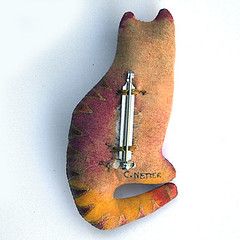Saturday, June 30, 2012
Billions of Buzzing Bees
It's probably only thousands of bees, but it looks like a lot to me. I just put out a fresh pan of honey comb for the bees to clean up. This time I smashed it up really well before putting it out so the bees could do a good job of getting the honey out. Once they are done with it, I'll melt the comb down, filter it, and use it for candles.
Monday, June 25, 2012
More Colorado Native Bees
Continuing from the previous post...
I used to think that honey bees did the vast majority of pollination in my yard here in Jefferson County, Colorado. The more I look, the more I notice just how many other insects are in my flowers and many of them are native Colorado bees.
This little green sweat bee, Augochlorella aurata, is often seen in the flowers of my sedum or dill weed. It is a very tiny bee with such a beautiful metallic sheen.
We also seem to have quite a variety of leaf cutter bees and their relatives. Besides this fellow from the last post, Lithurgus apicalis,
we also have other bees in the Megachilidae family such as this tiny white faced bee:
this little bee:
this little green eyed Anthidium oblongatum on sedum:
and this honeybee sized Megachile perihirta with the incredible orange butt:
And there are the bumble bees. Here's one in my Salvia transylvanica:
Here is the cute little orange striped bumble bee, Bombus huntii in Penstemon Red Rocks:
I used to think that honey bees did the vast majority of pollination in my yard here in Jefferson County, Colorado. The more I look, the more I notice just how many other insects are in my flowers and many of them are native Colorado bees.
This little green sweat bee, Augochlorella aurata, is often seen in the flowers of my sedum or dill weed. It is a very tiny bee with such a beautiful metallic sheen.
We also seem to have quite a variety of leaf cutter bees and their relatives. Besides this fellow from the last post, Lithurgus apicalis,
we also have other bees in the Megachilidae family such as this tiny white faced bee:
this little bee:
this little green eyed Anthidium oblongatum on sedum:
and this honeybee sized Megachile perihirta with the incredible orange butt:
And there are the bumble bees. Here's one in my Salvia transylvanica:
Here is the cute little orange striped bumble bee, Bombus huntii in Penstemon Red Rocks:
Labels:
bee,
bees,
bumble bee,
colorado,
Leaf cutter bee,
Native bees,
sweat bee
Friday, June 22, 2012
More and More Roses
And even more rose photos from my Colorado Garden, continuing from the last post...
Rose Gilardi is a nice miniature moss that is pink with red stripes.
High Country Banshee. This isn't the same as the Banshee described by Leonie Bell, but is a rose sold by High Country Roses. A very common graveyard rose, it's hardy and quite fragrant.
Jean Kenneally has near perfect blooms, each one on a long straight stem.
Kathryn Morley is a light pink English rose.
Leda with her red tipped petals.
Little Jackie, a nice little miniature bicolor.
Little Linda is a pale yellow micro mini that is one of my hardiest reblooming roses.
Madame Hardy, a lovely white with just a touch of pink once blooming damask.
Marie Pavie, a light pink polyantha.
Rose Gilardi is a nice miniature moss that is pink with red stripes.
High Country Banshee. This isn't the same as the Banshee described by Leonie Bell, but is a rose sold by High Country Roses. A very common graveyard rose, it's hardy and quite fragrant.
Jean Kenneally has near perfect blooms, each one on a long straight stem.
Kathryn Morley is a light pink English rose.
Leda with her red tipped petals.
Little Jackie, a nice little miniature bicolor.
Little Linda is a pale yellow micro mini that is one of my hardiest reblooming roses.
Madame Hardy, a lovely white with just a touch of pink once blooming damask.
Marie Pavie, a light pink polyantha.
Thursday, June 21, 2012
Even More Roses From My Colorado Garden
Continuing from my previous post...
Nymphenburg, a once blooming pink.
Mr. Nash, a large yellow climber that is usually a once bloomer. Sometimes it'll bloom a bit more late in the summer. Mr. Nash is the study name until it can be positively identified. So far it most likely seems to be Dubloons. Here it is as tall as the grape arbor which puts it at about eight feet tall.
Orange Honey is a nice little mini that gets redder as the blooms age.
Rainbow's End is another miniature rose that gets redder as the bloom ages.
Ralph's Creeper is supposed to get quite big, but stays the size of a miniature for me.
Rene d'Anjou is fragrant, repeat blooming moss.
Rose de Rescht, which is a nicely shaped little shrub that blooms all summer. The blooms have a strong scent.
Nymphenburg, a once blooming pink.
Mr. Nash, a large yellow climber that is usually a once bloomer. Sometimes it'll bloom a bit more late in the summer. Mr. Nash is the study name until it can be positively identified. So far it most likely seems to be Dubloons. Here it is as tall as the grape arbor which puts it at about eight feet tall.
Orange Honey is a nice little mini that gets redder as the blooms age.
Rainbow's End is another miniature rose that gets redder as the bloom ages.
Ralph's Creeper is supposed to get quite big, but stays the size of a miniature for me.
Rene d'Anjou is fragrant, repeat blooming moss.
Rose de Rescht, which is a nicely shaped little shrub that blooms all summer. The blooms have a strong scent.
Tuesday, June 19, 2012
The Beekeeper Inspects His Hives
Today the beekeeper came over to see how the hives are doing. I stood back and took lots of pictures which can be seen in this slide view:
Some of the comb is held in the frames by chicken wire. This comb came from the original hive that was removed from somebody's house and the chicken wire holds it in place until the bees have glued it into the frames with more wax. When the comb is sufficiently fixed into the frames by the bees, the beekeeper removes the chicken wire.
Some of these hives came from swarms and some from hive removals from buildings. So far, they all are making brood, which is a good sign.
Some of the comb is held in the frames by chicken wire. This comb came from the original hive that was removed from somebody's house and the chicken wire holds it in place until the bees have glued it into the frames with more wax. When the comb is sufficiently fixed into the frames by the bees, the beekeeper removes the chicken wire.
Some of these hives came from swarms and some from hive removals from buildings. So far, they all are making brood, which is a good sign.
Labels:
beehives,
beekeeper,
bees,
Dakota Bees
Sunday, June 17, 2012
The Solar Beeswax Melter
Recently, the beekeeper who has hives in my yard brought over some comb for the bees to clean up. The bees eagerly went to work cleaning the honey off this sticky wax.
After they were done with it, I put some of this wax in my solar wax melter to melt and filter the comb and hopefully end up with nice clean beeswax. I had all the parts to make this solar wax melter so it cost me nothing. It's made from a large Styrofoam box that my medicine comes in, a piece of plexiglass that was laying around, some nylon door screen that was also laying around, a piece of paper towel to filter the wax and a bungee to hold the plexiglass on.
First, some water was put into the Styrofoam box, after which the door screen was put across the top of the box and held in place with sewing pins. After that, I laid a paper towel on the screen and put the messy comb on that. Finally, the plexiglass was placed on top and held in place with the bungee cord. The box was placed in full sun and allowed to sit there all day. When the wax melted through the paper towel, it dripped through and fell into the water, where it hardened. The wax floated to the top and any honey still in the comb sunk to the bottom. Later the next morning, when it had all cooled down, I scooped the wax out using a little fine mess strainer.
Here is the fresh, unmelted comb:
Here is what's left, a day later. All brown stuff is junk I don't want in the beeswax. But I saved this dirty waxy paper towel to use as a fire starter for when we want a fire in the back porch fire pit.
And here is the nice clean wax that I will use to make candles with:
After they were done with it, I put some of this wax in my solar wax melter to melt and filter the comb and hopefully end up with nice clean beeswax. I had all the parts to make this solar wax melter so it cost me nothing. It's made from a large Styrofoam box that my medicine comes in, a piece of plexiglass that was laying around, some nylon door screen that was also laying around, a piece of paper towel to filter the wax and a bungee to hold the plexiglass on.
First, some water was put into the Styrofoam box, after which the door screen was put across the top of the box and held in place with sewing pins. After that, I laid a paper towel on the screen and put the messy comb on that. Finally, the plexiglass was placed on top and held in place with the bungee cord. The box was placed in full sun and allowed to sit there all day. When the wax melted through the paper towel, it dripped through and fell into the water, where it hardened. The wax floated to the top and any honey still in the comb sunk to the bottom. Later the next morning, when it had all cooled down, I scooped the wax out using a little fine mess strainer.
Here is the fresh, unmelted comb:
Here is what's left, a day later. All brown stuff is junk I don't want in the beeswax. But I saved this dirty waxy paper towel to use as a fire starter for when we want a fire in the back porch fire pit.
And here is the nice clean wax that I will use to make candles with:
Labels:
bees,
beeswax,
beeswax renderer,
honeybees,
solar beeswax melter
Friday, June 15, 2012
Strawberries!
Fresh picked organic strawberries from the garden.We've been getting about this amount per day for the last week. Yum!
Labels:
garden,
strawberries
Thursday, June 14, 2012
Native Bees of Colorado
I knew that there were native bees, but I didn't know there were so many native bees until Greg, of Dakota Bees, told me. There are four thousand species of bee in North America. So, I started looking at my blooming plants and noticed that there were many bees other than honey bees. Many of the native bees are very tiny.
Here's teeny one. It's a small carpenter bee, Ceratina, on the flower of Centaurea. Look at all the white pollen on it's leg.
To show how tiny it is, here it is with a honey bee:
Another tiny one is this sweat bee, Halictus:
Here it is with some honey bees to compare with.
On the opposite side of the scale are the Bumble Bees. Here is a biggy, Bombus nevadensis, having trouble getting into Penstemon strictus otherwise known as Rocky Mountain penstemon.
A much smaller bumble bee is the brown belted bumble bee, Bombus griseocollis, here in my spotted gallica rose:
Here is a ground bee, Anthophora bomboides, with an amazing mouth:
This is a leaf cutter bee. I've seen plenty of it's workmanship on my roses, but hadn't seen the culprit until now. Lithurgus apicalis:
Here's teeny one. It's a small carpenter bee, Ceratina, on the flower of Centaurea. Look at all the white pollen on it's leg.
To show how tiny it is, here it is with a honey bee:
Another tiny one is this sweat bee, Halictus:
Here it is with some honey bees to compare with.
On the opposite side of the scale are the Bumble Bees. Here is a biggy, Bombus nevadensis, having trouble getting into Penstemon strictus otherwise known as Rocky Mountain penstemon.
A much smaller bumble bee is the brown belted bumble bee, Bombus griseocollis, here in my spotted gallica rose:
Here is a ground bee, Anthophora bomboides, with an amazing mouth:
This is a leaf cutter bee. I've seen plenty of it's workmanship on my roses, but hadn't seen the culprit until now. Lithurgus apicalis:
Labels:
bee,
bumble bee,
carpenter bee,
Leaf cutter bee,
Native bees,
sweat bee
More Rose Photos from my Colorado Garden
And the parade of roses continues....
William Lobb - a big sprawly purplish once blooming moss rose. The cotton wood cotton is always at peak when my once blooming roses are at their peak. It gets stuck on the moss of this rose.
Scentsational - a fragrant miniature from Nor'east.
Shooting Star is one of my oldest miniature roses.
Spotty is a seedling of Alain Blanchard. Like it's parent, it has spots, but even more so.
Teddy Bear is another Nor'East miniature with a lovely unusual color.
Tracy Wickham forms these perfect little bi-colored buds on a nice proportional plant. It's one of my favorite miniature roses.
This is an unknown once blooming rose. The blooms are nice and full and very fragrant and the bush is quite big.
Salute is such a bright red mini.
This is another unknown rose.
There are many more rose photos to come.
William Lobb - a big sprawly purplish once blooming moss rose. The cotton wood cotton is always at peak when my once blooming roses are at their peak. It gets stuck on the moss of this rose.
Scentsational - a fragrant miniature from Nor'east.
Shooting Star is one of my oldest miniature roses.
Spotty is a seedling of Alain Blanchard. Like it's parent, it has spots, but even more so.
Teddy Bear is another Nor'East miniature with a lovely unusual color.
Tracy Wickham forms these perfect little bi-colored buds on a nice proportional plant. It's one of my favorite miniature roses.
This is an unknown once blooming rose. The blooms are nice and full and very fragrant and the bush is quite big.
Salute is such a bright red mini.
This is another unknown rose.
There are many more rose photos to come.
Subscribe to:
Comments (Atom)































































